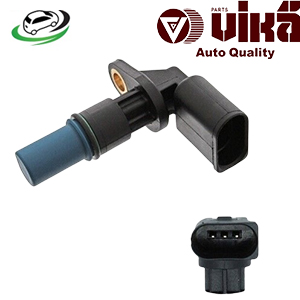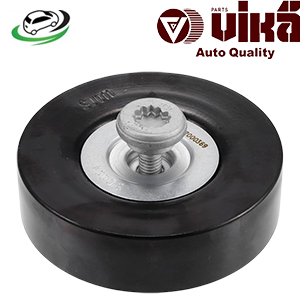-9%
Get AUDI B6 A4 1.8T/ AUDI B7 A4 2.0T Accessory Belt Idler Pulley 06B903341
The accessory belt idler pulley plays a critical role in the efficient functioning of a vehicle’s accessory drive system. The system is responsible for transferring power from the engine to various components such as the alternator, air conditioning compressor, power steering pump, and water pump. An accessory belt, often referred to as a serpentine belt, drives these accessories, and the idler pulley ensures the belt remains taut and properly aligned.
1. Functions of an Accessory Belt Idler Pulley
The idler pulley is a smooth or grooved wheel, usually made of metal or plastic, mounted on a bracket or a fixed point near the engine. Its primary functions are:
- Maintaining Tension: The accessory belt needs to remain at a specific tension to avoid slippage or wear. Although the tensioner pulley is the main component responsible for adjusting the tension, the idler pulley assists in ensuring that the belt runs smoothly along its designated path.
- Guiding the Belt: The idler pulley guides the serpentine belt through the system, ensuring that the belt stays aligned. Without proper alignment, the belt could come off the pulleys or wear unevenly, potentially leading to failure.
- Reducing Friction and Wear: The pulley reduces friction between the belt and other components by providing a low-resistance rolling surface. This helps prolong the lifespan of the belt and the accessories it powers.
- Supporting the Belt’s Path: In some configurations, the accessory belt requires routing over or under various engine components. The idler pulley ensures the belt runs smoothly over these obstacles, preventing excessive bending or twisting, which could damage the belt.
2. Benefits of an Accessory Belt Idler Pulley
A functioning idler pulley is essential for the proper operation of the accessory drive system. Here are some benefits of having a well-maintained idler pulley:
- Prevents Belt Slippage: The idler pulley works in tandem with the tensioner to keep the serpentine belt properly tensioned. Without adequate tension, the belt could slip, leading to poor performance of the accessories driven by the belt (such as a weak alternator output or reduced air conditioning efficiency).
- Ensures Smooth Operation of Accessories: By maintaining proper belt alignment and tension, the idler pulley helps ensure that accessories such as the alternator, water pump, and power steering function smoothly without disruptions.
- Extends Belt Life: By reducing friction and wear on the serpentine belt, the idler pulley contributes to the belt’s longevity. A well-aligned belt running on properly functioning pulleys lasts longer, reducing the need for frequent replacements.
- Prevents Overheating: In vehicles where the water pump is driven by the serpentine belt, an idler pulley is critical in ensuring proper water circulation. If the belt slips or breaks due to pulley failure, the water pump may stop functioning, leading to overheating of the engine.
- Reduces Noise and Vibrations: A worn-out or misaligned idler pulley can cause belt squealing or other noises. A functioning pulley ensures that the belt runs quietly and smoothly, contributing to a more pleasant driving experience.
3. Common Problems with Idler Pulleys
Though accessory belt idler pulleys are designed to last for several years, they are subject to wear and tear due to constant rotation and exposure to heat, dirt, and moisture. Common issues include:
- Bearing Wear: Idler pulleys are equipped with bearings that allow them to rotate freely. Over time, these bearings can wear out due to exposure to dirt, moisture, and heat. A failing bearing can result in a squealing noise, excessive pulley wobble, or complete failure of the pulley.
- Pulley Misalignment: If the idler pulley becomes misaligned, it can cause uneven belt wear, squealing noises, or even cause the belt to jump off the pulleys. Misalignment can result from a damaged pulley bracket or improper installation.
- Pulley Cracks or Breakage: The pulley itself, especially if made from plastic, can develop cracks over time. A cracked pulley can lead to belt misalignment, which in turn causes the belt to wear prematurely or fail.
- Seized Pulley: In some cases, the idler pulley’s bearing can seize, preventing the pulley from rotating. When this happens, the serpentine belt may either slip on the pulley or break entirely, resulting in failure of the accessory drive system.
4. Signs of a Faulty Idler Pulley
Detecting the early signs of a failing idler pulley can help prevent more serious problems. Some common symptoms of a faulty idler pulley include:
- Squealing or Grinding Noise: A worn-out bearing inside the pulley can cause a high-pitched squealing or grinding noise. This noise is often most noticeable when the engine is started or when the vehicle is idling.
- Visible Belt Wear: If the idler pulley is misaligned or seized, the serpentine belt may wear unevenly or develop cracks prematurely. Inspecting the belt for signs of wear is a good indicator of pulley problems.
- Vibration or Pulley Wobble: A loose or worn idler pulley can cause noticeable vibrations in the belt or engine compartment. If the pulley wobbles while the engine is running, it should be replaced immediately.
- Belt Slippage: A faulty idler pulley can lead to reduced tension on the serpentine belt, causing it to slip. This may result in poor performance of the accessories driven by the belt, such as a loss of power steering or air conditioning.
5. Maintenance Tips for Accessory Belt Idler Pulley
Proper maintenance of the idler pulley can help extend the life of the serpentine belt and other components in the accessory drive system. Here are some maintenance tips:
- Regular Inspections: Periodically inspect the idler pulley for signs of wear, such as cracks, bearing noise, or belt misalignment. Checking the pulley during routine maintenance, like an oil change, can help catch problems early.
- Replace Worn or Damaged Pulleys: If the idler pulley shows signs of damage, such as cracks, wobbles, or excessive noise, it’s essential to replace it promptly. Ignoring a worn pulley can lead to belt failure and the malfunction of critical components like the alternator and power steering.
- Lubrication of Bearings: Some idler pulleys have sealed bearings that require no maintenance, while others may need periodic lubrication. If applicable, lubricate the pulley’s bearings to ensure smooth rotation and reduce friction.
- Belt Replacement: When replacing the serpentine belt, it’s a good practice to inspect and, if necessary, replace the idler pulley. The pulley and belt often wear out at similar rates, so replacing both components together ensures optimal performance.
- Keep the Pulley Clean: Dirt, debris, and moisture can cause the pulley’s bearing to wear out prematurely. Keeping the pulley clean and free of contaminants can help prolong its lifespan.
6. Conclusion
The accessory belt idler pulley plays a vital role in the smooth operation of a vehicle’s accessory drive system. By maintaining proper belt tension and alignment, the idler pulley ensures that critical components like the alternator, air conditioning, and power steering function efficiently. Regular maintenance, including inspections and timely replacements, can help prevent costly breakdowns and keep the vehicle running smoothly.
Follow us on Facebook for more parts.




Reviews
Clear filtersThere are no reviews yet.